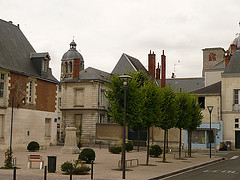One service admirably accomplished by the municipal, provincial, and federal government in Tours is the creation and maintenance of public spaces. Throughout the city, there are dozens of locations where citizens may relax, play chess or pétanque, view gardens or pieces of art, and otherwise enjoy themselves at no cost (I assume that they are paying for it with tax dollars but at least they get to benefit from their contribution to the system).
Over time, parts of Tours have been destroyed due to fire, Huguenots, Reformists, the French Revolution, and the air bombings of the Second World War. Plus the places that people demolished themselves because they felt the architectural style (in this case Gothic) was no longer fashionable. But the city usually rebuilds what has been lost, to some degree, or replaces it.
Place Plumereau is a lively outdoor square where tourists loiter and couples get married on the weekends. Place du 14 Juillet is a quiet area for conversations and a meeting place. Place Jean-Jaures is the centre of town, where almost all the bus routes connect. Le Jardin Botanique has a quaint petting zoo where lambs, calves, and roosters can congregate together.
For all of the benefit derived by citizens and the dollars gained from increased tourism, Tours profits from these spaces. Toronto lacks the foresight to design spaces properly, for example building a post-modern City Hall and then cramming it with gardens, fountains, vendors, and other urban detritus, and the wherewithal to maintain what already exists, illustrated by the decline of the Toronto Islands or parks where the equipment was removed due to excessive legal worries. When something potentially interesting is built, like Yonge-Dundas Square, it takes years to apply the finishing touches and even more to create an identity.
In this case, simplicity and giving everyone a little something, so they can see their property taxes at work, is the best way to reward citizens and promote the city.
